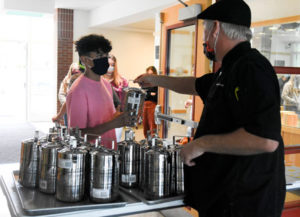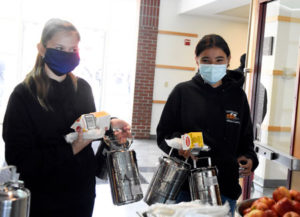Lincoln Academy students who purchase lunch will now eat it out of what are known as “tiffin” containers. Tiffins are reusable stainless-steel lunchboxes that can be washed and sanitized every day which will significantly reduce schools packaging costs as well as plastic waste.
Most schools use disposable plastic containers—thousands of them—to serve breakfast and lunch to students. Not Lincoln Academy.
 “I am anti-plastic completely,” said chef Mikael Andersson, who has been director of dining services at the school since 2016. In his time there, he has reduced the use of disposable containers and flatware and used paper instead of plastic whenever possible if to-go containers are necessary.
“I am anti-plastic completely,” said chef Mikael Andersson, who has been director of dining services at the school since 2016. In his time there, he has reduced the use of disposable containers and flatware and used paper instead of plastic whenever possible if to-go containers are necessary.
During the school closure last spring, Andersson prepared meals for delivery to 125 families twice a week. By necessity these deliveries included plastic containers with prepared meals, as well as kits to cook at home.
“I hated using all that plastic,” he said. “Even though the containers we use are technically compostable, they really need an industrial composting facility in order to break down. Let’s face it: most of them end up in the landfill.”
While planning for the fall return to school, Andersson explored his alternatives.
“I thought about paper containers, but paper gets soggy when you put food in it. My only other alternative would have been styrofoam or plastic. Then I ran the numbers: at 750 containers a week, that’s 3000 per month, 30,000 for the school year. That is a lot of containers, and it’s expensive.”
Andersson also considered the environmental implications.
“I can’t imagine all that single-stream plastic in the landfill. I started thinking about all the schools in the country; even all the schools in Lincoln County, and thought, ‘What can I do to help?’”
After assessing the challenges, including meal preparation, container collection, sanitizing, and more, Andersson settled on the idea of traditional stainless-steel stacking food containers known as tiffins that have been used all over the word for a century or more.

“My dad took a similar lunch box to work every day, when he worked as a technician for the Swedish air force,” said Andersson, who grew up in Sweden. “After dinner he would pack up the leftovers, and the next morning he took that metal container to work and put it in a warming box. At noon every day he had a nice warm lunch.”
Andersson did his research, investigating several dozen models before finding one he liked.
“I need a seamless, insulated tiffin. Seams are hard to keep clean, and water can get into them and compromise them over time. I finally found these, and they are great! And the company even engraved the L.A. logo on them.”
In the end, he sourced 200 engraved stainless steel tiffins for about a quarter of what disposable containers would have cost for the year.
The tiffin transition is not without challenges.
“We have to rethink how we plan and cook food and how we clean up,” Andersson said. “Filling, stacking, and locking each container takes time, and then we will be delivering to classrooms and picking up after lunch.”
For Andersson, it is worth it. “I love serving lunch in these cool, old-fashioned lunch boxes. And it is so much better for the planet.”





